Marrying Vega and Zen: The AMD Ryzen 5 2400G Review
by Ian Cutress on February 12, 2018 9:00 AM ESTiGPU Gaming Performance
Throughout their history of having fully integrated GPUs, AMD has always favored going for powerful configurations that approach the lower-end of discrete GPU performance. With comparable discrete cards going for $80 or more, a powerful iGPU is a significant value proposition for AMD’s APUs. Furthermore as Intel has continued to stick with relatively lightweight iGPUs for most mainstream SKUs – a trend even the newly released “Coffee Lake” 8th Gen Core family continues – AMD has easily trounced Intel’s iGPU performance.
In fact the most recent 8th Gen Core CPUs generally fail to catch up to AMD’s last-generation 7000/8000 series “Kaveri” APUs, which means that for the launch of AMD’s new Ryzen APUs, the manufacturer is just going to be running up the lead even more. The real question we’ll be looking at on the iGPU side isn’t what’s faster – that’s obvious – but just how many times faster the 2400G & 2200G APUs are over their Intel equivalents, and how they stack up against an entry level discrete video card, the GeForce GT 1030. With upwards of 11 CUs in an APU, on paper the Ryzen APUs should be able to offer 1080p@30fps gaming at maximum (or near-maximum) image quality.
During our pre-briefing, several sets of benchmarks and configurations were 'suggested', focusing on eSports and a mid-range quality setting, to show what the platform can do. For our testing, we used our CPU Gaming 1080p gaming suite. This suite was developed with mid-range and high-end graphics cards in mind, with mostly high or ultra quality settings, pushing beyond what was suggested. The reason we did this was two fold:
- In our data, it shows a sizeable difference between integrated graphics solutions that can offer potential, compared to those that fall at the first hurdle.
- Second, it offers a stark reminder that while for the most part websites and enthusiasts like as way lyrical about high-end performance, the data shows both how far integrated graphics has come, and how far it still has to go to qualify for those 'immerse experiences' that Intel, AMD, and NVIDIA all claim are worth reaching for, with higher resolutions and higher fidelity.
Civilization 6
First up in our CPU gaming tests is Civilization 6. Originally penned by Sid Meier and his team, the Civ series of turn-based strategy games are a cult classic, and many an excuse for an all-nighter trying to get Gandhi to declare war on you due to an integer overflow. Truth be told I never actually played the first version, but every edition from the second to the sixth, including the fourth as voiced by the late Leonard Nimoy, it a game that is easy to pick up, but hard to master.
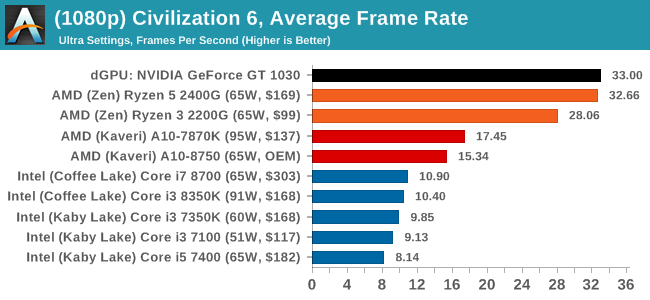

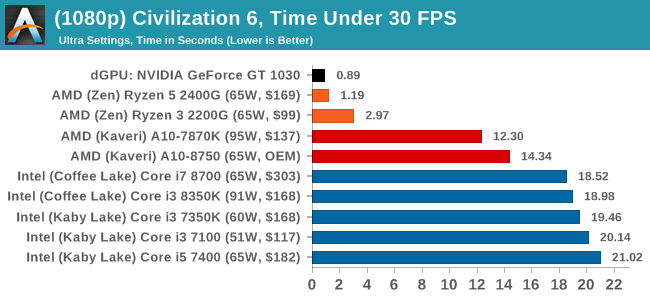
While Civilization is not too limited to frame rates, the APUs straddle the 30FPS average, and the GT 1030 comes out on top just about. Intel's integrated graphics options are only 1/3 of what AMD is providing in this case.
Shadow of Mordor
The next title in our testing is a battle of system performance with the open world action-adventure title, Middle Earth: Shadow of Mordor (SoM for short). Produced by Monolith and using the LithTech Jupiter EX engine and numerous detail add-ons, SoM goes for detail and complexity. The main story itself was written by the same writer as Red Dead Redemption, and it received Zero Punctuation’s Game of The Year in 2014.
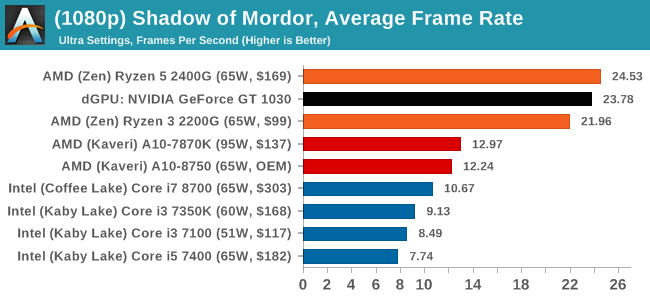
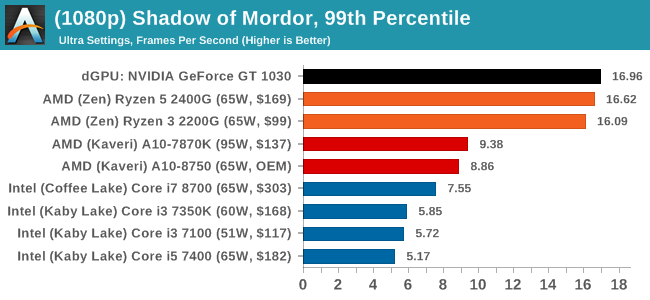
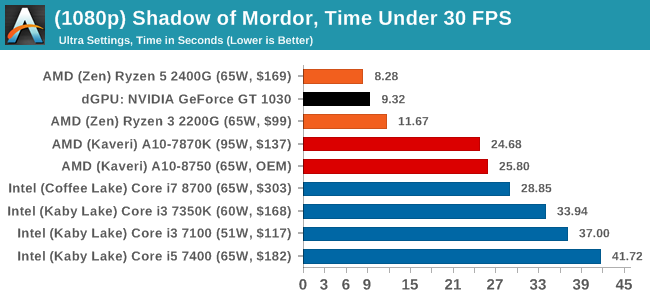
In Shadow of Mordor, the 2400G takes the top spot in average frame rates, but the GT 1030 just wins on percentiles. Over Kaveri, AMD is now offering double the graphics performance, and over Intel, AMD is easily 2-3x in performance per dollar.
Grand Theft Auto V
The highly anticipated iteration of the Grand Theft Auto franchise hit the shelves on April 14th 2015, with both AMD and NVIDIA in tow to help optimize the title. GTA doesn’t provide graphical presets, but opens up the options to users and extends the boundaries by pushing even the hardest systems to the limit using Rockstar’s Advanced Game Engine under DirectX 11. Whether the user is flying high in the mountains with long draw distances or dealing with assorted trash in the city, when cranked up to maximum it creates stunning visuals but hard work for both the CPU and the GPU.
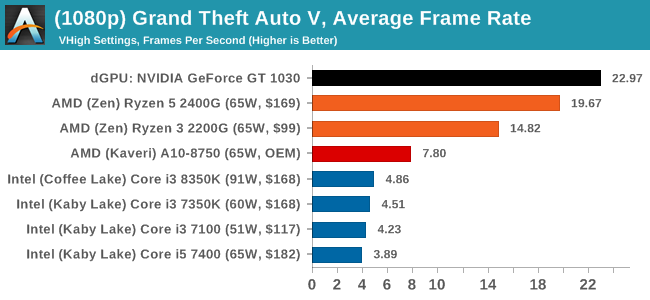
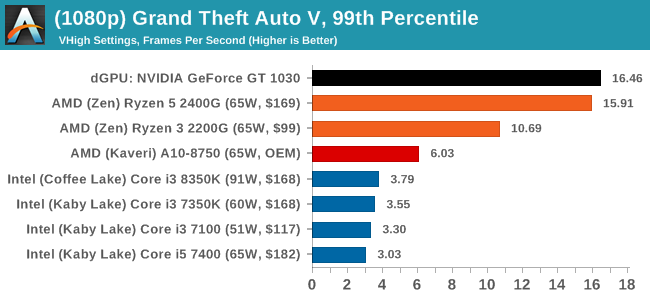

The difference between something playable and a slide show was easily noticable in GTA. The GT 1030 had the legs on this one, although the gap between the two AMD parts was mostly noticable in 99th percentile numbers.










177 Comments
View All Comments
AndrewJacksonZA - Monday, February 12, 2018 - link
Hi Ian. I'm still on page one but I'm so excited! Can a 4xx Polaris card be Crossfired with this APU?prtskg - Tuesday, February 13, 2018 - link
No crossfire supported by these apus, according to AMD. You can check it out on AMD's product page.dgingeri - Monday, February 12, 2018 - link
How many PCIe lanes are available on them? I didn't see that info anywhere in the article.iter - Monday, February 12, 2018 - link
Only 8dgingeri - Monday, February 12, 2018 - link
Well, not great, but it can still run a RAID controller off the CPU lanes and a single port of 10Gbe from the chipset, or run a dual port 10Gbe from the CPU and a lower end SATA HBA from PCIex4 from the chipset with software RAID. The 2200G could make a decent storage server with a decent B350 board. I could do more with 16 lanes, but 8 is still workable. It's far cheaper than running a Ryzen 1200 with a X370 board and a graphics card with the same amount of lanes available for IO use and a faster CPU.Geranium - Monday, February 12, 2018 - link
8 PCIe Gen3 for gpu+4 Gen3 for SSD+4 Gen3 for Chipset.andrewaggb - Monday, February 12, 2018 - link
What's with the gaming benchmarks... Is there a valid reason that no games were benchmarked at playable settings? I'm going to have to go to another site to find out if these can get 60ish fps on medium or low settings.... And I thought these were being pitched at esports... so some overwatch and dota numbers might have been appropriate.AndrewJacksonZA - Monday, February 12, 2018 - link
"and can post 1920x1080 gaming results above 49 FPS in titles such as Battlefield One, Overwatch, Rocket League, and Skyrim, having 2x to 3x higher framerates than Intel’s integrated graphics. This is a claim we can confirm in this review.""These games are a cross of mix of eSports and high-end titles, and to be honest, we have pushed the quality settings up higher than most people would expect for this level of integrated graphics: most benchmarks hit around 25-30 FPS average with the best IGP solutions, down to 1/3 this with the worst solutions. The best results show that integrated graphics are certainly capable with the right settings, but also shows that there is a long way between integrated graphics and a mid-range discrete graphics option."
I would love to see which settings BF1 would have 49FPS please. Is it with everything on low, medium?
Ian Cutress - Monday, February 12, 2018 - link
I've added some sentences to the IGP page while I'm on the road. We used our 1080 high/ultra CPU Gaming suite for two reasons.Manch - Monday, February 12, 2018 - link
Which are?